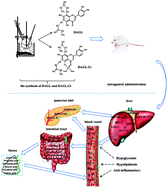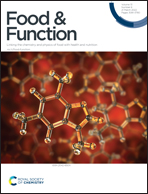6,8-(1,3-Diaminoguanidine) luteolin and its Cr complex show hypoglycemic activities and alter intestinal microbiota composition in type 2 diabetes mice†
Abstract
Flavonoid compounds such as luteolin exhibit hypolipidemic effects, and there are few reports on the hypoglycemic activity of luteolin derivatives. In this research, 6,8-(1,3-diaminoguanidine) luteolin (DAGL) and its Cr complex (DAGL·Cr) were obtained as a result of structural modifications to luteolin, and the hypoglycemic activities and the composition of intestinal microbiota in T2DM mice were investigated. This study found that DAGL and DAGL·Cr could significantly restore body weight, FBG, OGTT, AUC, and GSP in T2DM mice. Moreover, the pancreatic islet function index and the biochemical indicators of serum and the liver were also significantly improved. The histopathological results also showed that DAGL and DAGL·Cr had a stronger repair ability in the liver and the pancreas. It was also revealed that the potential hypoglycemic mechanism of DAGL and DAGL·Cr was involved in the simultaneous regulation of PI3K/AKT-1/GSK-3β/GLUT-4 and PI3K/AKT-1/mTOR/S6K1/IRS-1. Furthermore, DAGL and DAGL·Cr could also regulate the structure of the intestinal microbiota and increase the content of SCFA to relieve the symptoms of hyperglycemia in T2DM mice. This included a significant reduction in the ratio of Firmicutes and Bacteroidetes (F/B), and at the genus level, an increase in the relative abundance of Alistipe and Ruminiclostridium, and improvement in the content of SCFA in the feces of T2DM mice. In conclusion, in this study, DAGL and DAGL·Cr were found to improve hyperglycemia in T2DM mice by improving the pancreatic islet function index, regulating the biochemical indicators of serum and the liver, repairing damaged tissues, and regulating the PI3K/AKT-1 signaling pathway as well as reducing F/B, increasing the relative abundance of intestinal beneficial microbiota, and the content of SCFA in the feces. The hypoglycemic effect of DAGL·Cr on the body weight, serum IL-10, serum IL-6, and pancreatic islet function index was significantly better than that of DAGL.



 Please wait while we load your content...
Please wait while we load your content...